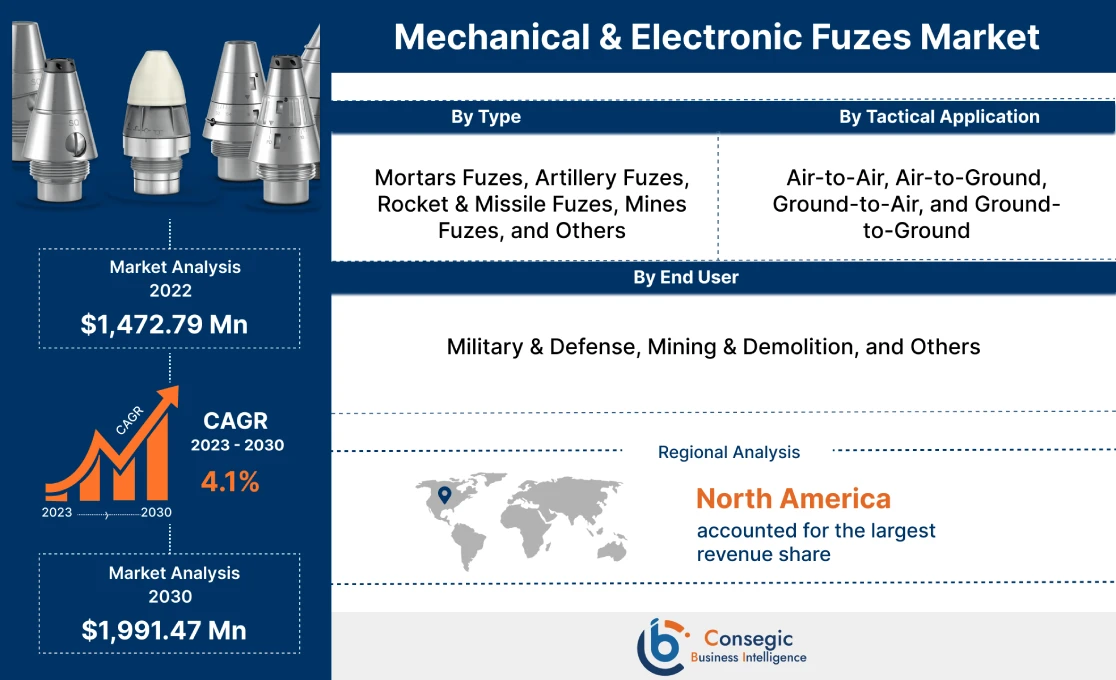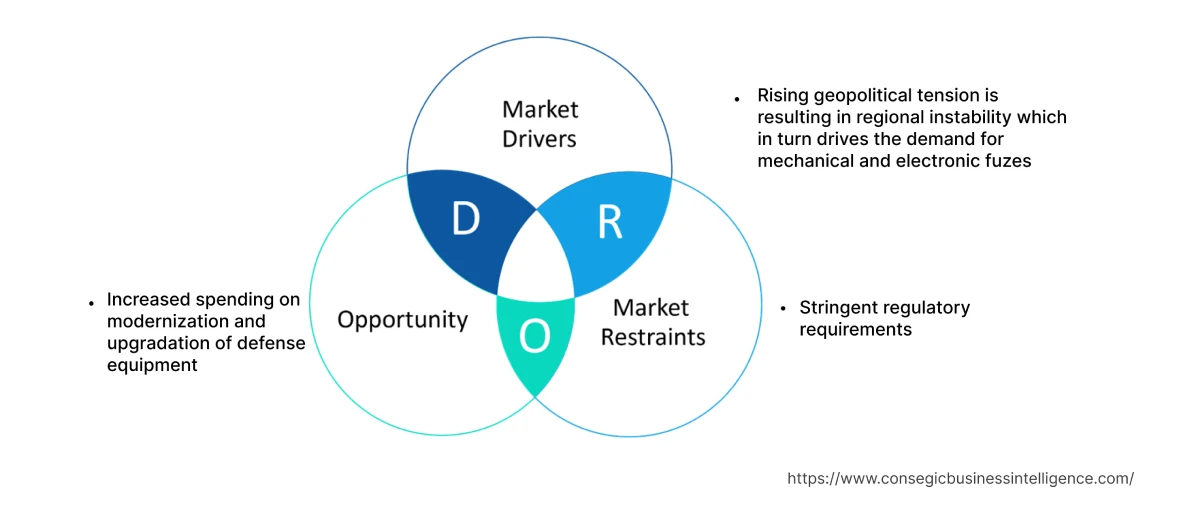Mechanical and Electronic Fuzes Market Introduction :
Mechanical & Electronic Fuzes Market is estimated to reach over USD 1,991.47 Million by 2030 from a value of USD 1,472.79 Million in 2022, growing at a CAGR of 4.1% from 2023 to 2030.
Mechanical and Electronic Fuzes Market Definition & Overview:
Mechanical and electronic fuzes are two distinct types of fuzes that are used in explosive ordnance. Mechanical fuzes rely on mechanical mechanisms to control the initiation or timing of detonation and consist of a combination of springs, levers, gears, and other mechanical components. Moreover, electronic fuzes incorporate advanced electronic components and technologies to control the initiation process. Electronic fuzes typically utilize microprocessors, sensors, programmable logic, and communication systems to achieve precise and configurable detonation functions.
Mechanical and Electronic Fuzes Market Insights :
Mechanical and Electronic Fuzes Market Dynamics - (DRO) :
Key Drivers :
Rising geopolitical tension is resulting in regional instability which in turn drives the demand for mechanical and electronic fuzes
Geopolitical conflicts refer to disputes and tensions that arise between nations or regions due to competing interests and conflicting goals related to political, economic, social, or strategic interests. Geopolitical conflicts have far-reaching consequences, including political instability, humanitarian crises, and increased military tensions. One of the recently rising conflicts is the Russia- Ukraine war that has encouraged the countries in the European Union to invest more in defense expenditure. For instance, German Chancellor Olaf Scholz in January 2022 announced a special defense fund worth USD 112.7 billion in response to Russia's invasion on Ukraine. Further, according to the UK's Ministry of defense, spending on defense for 2021-2022 was 71.4 billion Pounds making the country the fifth-highest spender on defense.
Another major rising conflict is the instability in the South China Sea where countries including China, Vietnam, Philippines, and Malaysia are competing for territorial claims. The rising military spending in the aforementioned countries has resulted in the increased demand for mechanical and electronic fuzes. The military uses fuzes for a wide range of applications including mortars, artillery, mines, tanks and rockets among others. Thus, rising geopolitical tensions are resulting in the increased demand for the mechanical and electronic fuzes
Key Restraints :
Stringent regulatory requirements
The fuzes are critical components of ammunition and explosives that make reliability & safety key requirement. As a result, the regulatory bodies often establish strict guidelines and standards that manufacture of the fuzes has to follow to minimize the risk of accidental detonations. Meeting regulatory requirements often involves additional costs for manufacturers including investment in testing, certification, and documentation processes to demonstrate the compliance. The costs increase the overall production costs of fuzes which in turn impacts the pricing and market competitiveness.
Future Opportunities :
Increased spending on modernization and upgradation of defense equipment
Modernization and upgrading of defense equipment refers to the process of improving and enhancing the capabilities of existing military hardware, software, and other related systems. The upgradation is done to ensure that military forces are equipped with the latest technology and equipment that is safe, reliable, and precise. For instance, according to Government of India, the total defense budget for 2023 is USD 81.4 billion and 23% of the total budget is allocated on upgradation of military equipment. Further, according to Defense Acquisition Council of India on March 2023, the country approved the purchase of military equipment worth 8.5 billion dollars. The purchase includes electronic warfare systems, helicopters, missiles, and artillery guns. Further, according to a report from Reuters in February 2023, U.S. State Department approved sale of rockets, launchers, and long-range missiles worth USD 10 billion to Poland. The mechanical and electronic fuzes are integral parts of the missile & rockets and are used for controlling the detonation of ammunition. Thus, growing investment on upgradation and modernization offers opportunities for the market growth of mechanical and electronic fuzes.
Mechanical and Electronic Fuzes Market Report Insights :
| Report Attributes | Report Details |
| Study Timeline | 2017-2030 |
| Market Size in 2030 | USD 1,991.47 Million |
| CAGR (2023-2030) | 4.1% |
| By Type | Mortars Fuzes, Artillery Fuzes, Rocket & Missile Fuzes, Mines Fuzes, and Others |
| By Tactical Application | Air-to-Air, Air-to-Ground, Ground-to-Air, and Ground-to-Ground |
| By End User | Military & Defense, Mining & Demolition, and Others |
| By Region | North America, Europe, Asia-Pacific, Latin America, Middle East & Africa |
| Key Players | L3 Technologies, Reshef Technologies, Kaman Corporation, Expal, JUNGHANS Microtec GmbH, Fuchs Electronics, DIXI Microtechniques, Anhui Great Wall Military Industry, Sandeep Metalcraft, Action Manufacturing Company, Inc. |
Mechanical and Electronic Fuzes Market Segmental Analysis :
Based on the Type :
The type segment is classified into mortars fuzes, artillery fuzes, rocket & missile fuzes, mines fuzes, and others. The mortars fuzes segment accounted for the largest market share in 2022 and is expected to witness highest CAGR during the forecast period. The increasing demand for mortar in close combat is driving the market growth of mortar fuzes. The fuzes play an important role in close combat operations by neutralizing threats and providing support to the forces. Further, mortars are a crucial component of indirect fire support in military operations. The demand for mortar fuzes arises to deliver mortar effectively and accurately on enemy targets.
The rocket & missile fuzes are expected to register the fastest CAGR growth during the forecast period. The increased demand for modern warfare systems has resulted in the significant growth in the missile and rocket which in turn spurs the demand for fuzes. The mechanical and electronic fuzes are used in rockets & missiles to control the detonation. The mechanical fuzes typically involve physical components such as impact or time delay mechanism that controls the explosion at a desired time. Moreover, electronic fuzes utilize advanced electronic components and technologies to provide more precise control over detonation.
Based on the Tactical Application :
The tactical application segment is classified into air-to-air, air-to-ground, ground-to-air, and ground-to-ground. The ground-to-air segment accounted for the largest market share in 2022 and anticipated to grow at a fastest CAGR during forecast period. The ground-to-ground system includes a wide range of military equipment including rockets, mines, artillery, and mortars among others. The equipment relies on fuzes for proximity detonation and time delayed detonations. Further, the fuzes are utilized in artillery shells, mortar rounds, surface to surface missiles and other ground launched ordnance. In addition, significant reliance on ground-to-ground systems in military operations is driving the market growth.
Based on the End-User :
The end user segment is classified into military & defense, mining & demolition, and others. The military & defense segment accounting for the largest market share in 2022 is expected to growth with a highest CAGR. The growing expenditure on military & defense globally is driving the demand for mechanical and electronic fuzes. For instance, according to World Bank the defense budget of China rose from USD 232.5 billion in 2018 to USD 293.5 billion in 2021. The rising defense budget of China is resulting in increased investment in a wide range of military equipment including rockets, missiles, and mines among others. Thus, the increased spending on military equipment is resulting in the increased demand for the mechanical and electronic fuzes.
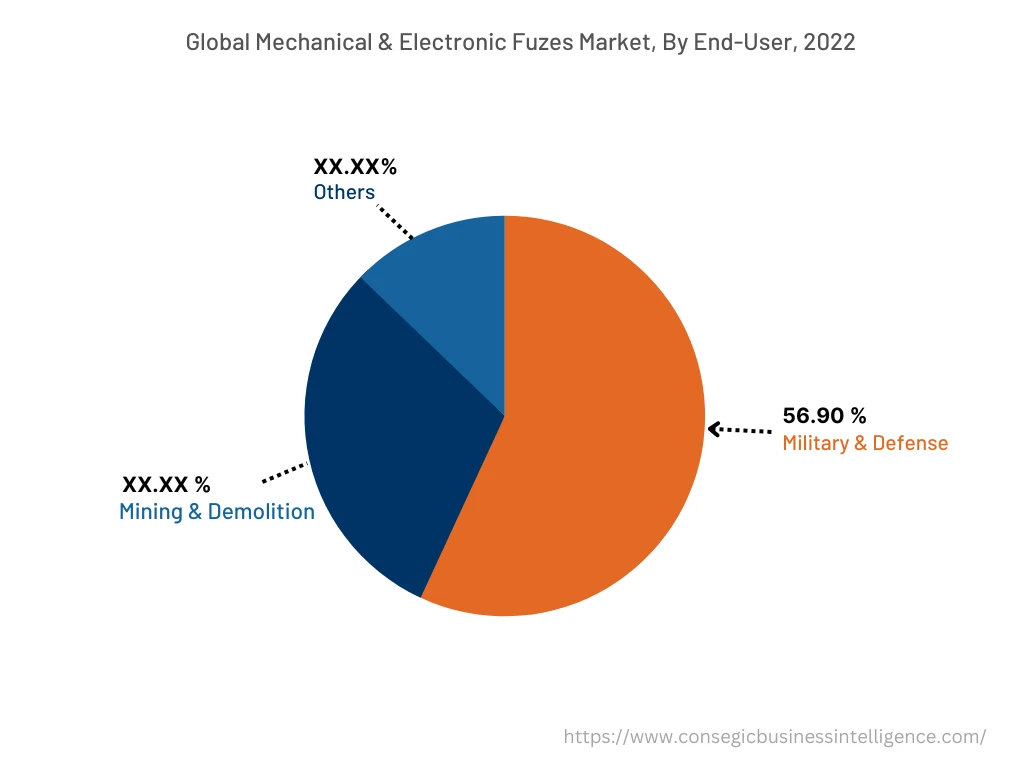
Based on the Region :
The regional segment includes North America, Europe, Asia Pacific, Middle East and Africa, and Latin America.
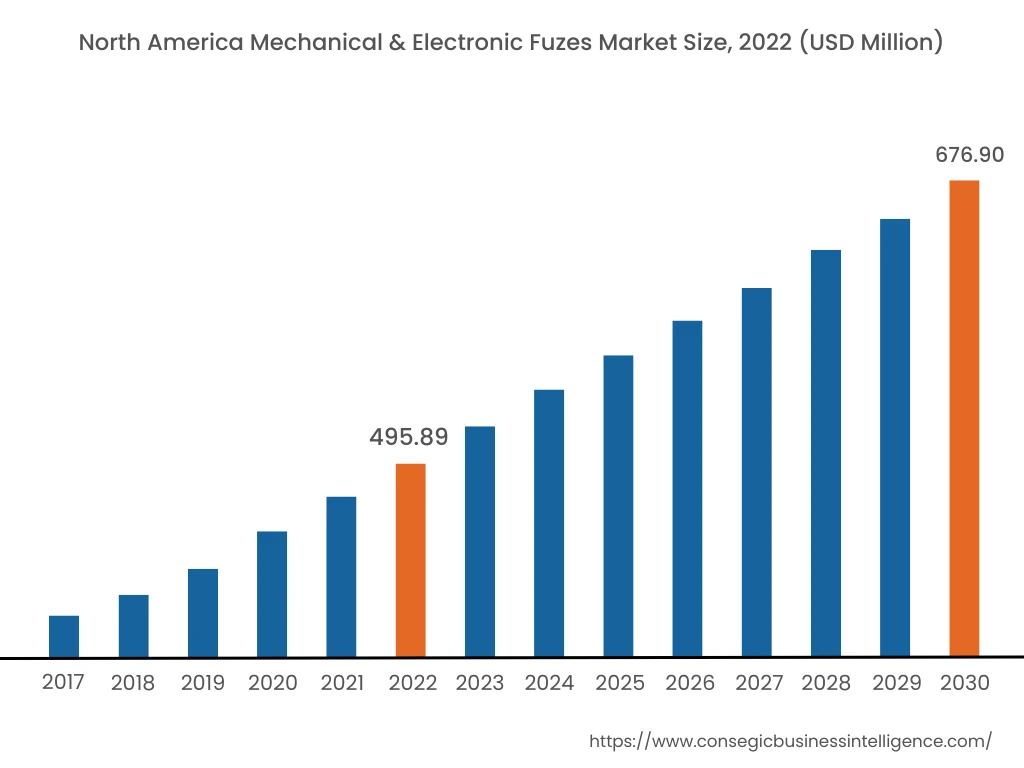
North America accounted for the largest revenue share of 33.67% in the year 2022 and is projected to grow at a CAGR of 4.2% during the forecast period. The growth aerospace & defense industry is spurring the market growth of mechanical & electronic fuzes. Aerospace & defense is the leading industrial sector of North America. According to Aerospace Industries Association, in 2020, the Aerospace & Defense industry accounted for 1.8% (USD 738 billion) of the total U.S. GDP valued at USD 21.49 trillion. The aerospace industry uses mechanical fuzes in air-to-air missiles to arm and detonate warheads. Further, the fuses are used in rocket propelled grenades to trigger the explosion when warhead strikes the target. Thus, growing aerospace & defense industry in the region is boosting the maket growth of the mechanical & electronic fuzes.
Asia Pacific accounted for USD 410.76 Million in 2022 and is anticipated to witness the fastest CAGR of 4.5% in the mechanical & electronic fuzes market during the forecast period. In addition, in the region China and India demonstrates significant spending on military services. For instance, according to Stockholm International Peace Research Institute (SIPRI), in 2021, China military spending amounted to USD 293.35 billion. According to Stockholm International Peace Research Institute, the military expenditure in India increased to USD 76,598 million in 2021 from USD 72,937.10 million in 2020. The increased spending on defense in the region is resulting in the significant growth of mechanical & electronic fuzes.
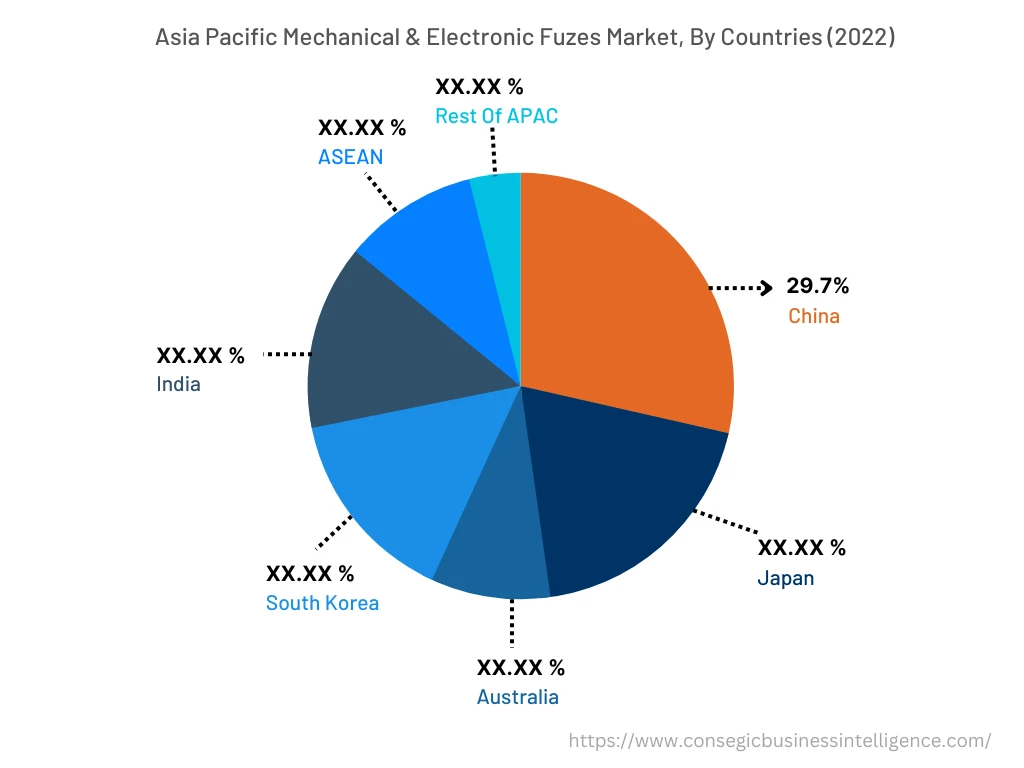
Top Key Players & Market Share Insights:
The competitive landscape of the Mechanical & Electronic Fuzes market has been analyzed in the report, along with the detailed profiles of the major players operating in the industry. Further, the surge in Research and Development (R&D), product innovation, various business strategies, and application launches have accelerated the growth of the Mechanical & Electronic Fuzes Market. Key players in the Mechanical & Electronic Fuzes Market include-
- DIXI Microtechniques
- Anhui Great Wall Military Industry
- Sandeep Metalcraft
- Action Manufacturing Company, Inc.
- Fuchs Electronics
- Reshef Technologies
- L3 Technologies
- Kaman Corporation
- Expal
- JUNGHANS Microtec GmbH
Recent Industry Developments :
- In August 2021, Kaman Corporation announced the order of Joint Programmable Fuze (JPF) contract worth USD 43 Million with the U.S. Air Force (USAF)
- In October 2021, Fuchs Electronics (Pty) Ltd a member of Reunert Group announced the amalgamation of DoppTech (Pty) Ltd into the Electronic fuze fold. DoppTech's focusses on design and development of technology for medium caliber fuzes (prominently 40mm fuze).
Key Questions Answered in the Report
What is Mechanical & Electronic Fuzes? +
Mechanical & electronic fuzes are devices that are used to ensure that the explosive device detonates at the desired moment, maximizing the effectiveness while minimizing the risk of accidental detonation.
What specific segmentation details are covered in the Mechanical & Electronic Fuzes Market report, and how is the dominating segment impacting the market growth? +
The report consists of segments including type, tactical application, and end user. Each segment has a key dominating sub-segment being driven by industry trends and market dynamics. For instance, in the application segment ground to ground as the dominating segment in the year 2022. The growth is attributed to growing demand for mechanical and electronic fuzes in the close combat military equipment including artillery, mortar, and rockets.
What specific segmentation details are covered in the Mechanical & Electronic Fuzes market report, and how is the fastest segment anticipated to impact the market growth? +
In Type segment, the rocket & missile fuzes are anticipated to witness the fastest CAGR growth during the forecast period. The growth is attributed to the increased demand for modern warfare systems that has resulted in the significant growth in missiles and rockets.
What specific segmentation details are covered in the Mechanical & Electronic Fuzes market report, and how does each dominating segment is influencing the demand globally? +
As aforementioned, each dominating segment is influencing the demand globally due to growing industrial needs. Moreover, fluctuation in demand being witnessed from different sectors is responsible for driving the mechanical & electronic fuzes market.
